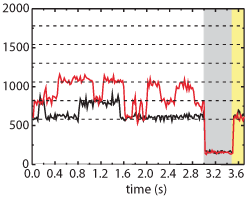Single Atoms in a Quantum Gas
Single neutral atoms as well as quantum gases are well controllable model systems for quantum mechanical phenomena. The controlled immersion of a single atomic impurity into a quantum gas allows to increase the control over both sub-systems even further and to exploit them for applications in quantum simulations and quantum information processing.
Methods Ultra-cold temperatures are necessary for neutral atoms to behave as quantum objects. Therefore, a small amount of Rubidium or Cesium atoms is contained in an ultra-high vacuum chamber. By means of laser cooling these atoms are cooled close to absolute zero Kelvin, and by laser beams they are trapped in space. Depending on the experimenter's choice, a single or up to 106 atoms can be trapped.
Single Atoms as Probes for a Rb Magneto-Optical Trap
 Fluorescence dynamics of single Cesium atoms for different Rubidium atom numbers in a magneto-optical trap (click on image to see the complete view). Fluorescence dynamics of single Cesium atoms for different Rubidium atom numbers in a magneto-optical trap. Interaction of atoms at ultra-cold temperatures leads to strong atom loss from the trap, if the system is illuminated with near-resonant light. For the interaction of two different species such losses result from different mechanisms. In order to investigate such systems in detail, we have developed a method using single Cesium atoms as probes for individual light-induced loss events. In a magneto-optical trap (MOT) single Cesium atoms are trapped and their fluorescence is recorded. Via interaction with a large Rubidium MOT Cesium atoms are lost, leading to blinking-type dynamics of the Cesium fluorescence. Analysis of the fluorescence dynamics allows to extract information on the interaction between the two species without affecting the Rubidium system at all.
Fluorescence dynamics of single Cesium atoms for different Rubidium atom numbers in a magneto-optical trap (click on image to see the complete view). Fluorescence dynamics of single Cesium atoms for different Rubidium atom numbers in a magneto-optical trap. Interaction of atoms at ultra-cold temperatures leads to strong atom loss from the trap, if the system is illuminated with near-resonant light. For the interaction of two different species such losses result from different mechanisms. In order to investigate such systems in detail, we have developed a method using single Cesium atoms as probes for individual light-induced loss events. In a magneto-optical trap (MOT) single Cesium atoms are trapped and their fluorescence is recorded. Via interaction with a large Rubidium MOT Cesium atoms are lost, leading to blinking-type dynamics of the Cesium fluorescence. Analysis of the fluorescence dynamics allows to extract information on the interaction between the two species without affecting the Rubidium system at all.
More details can be found in our publication PRA 82, 042722.










